Abstract
Cytotoxic T lymphocyte (CTL) clones specific for human minor histocompatibility antigens (hmHAs) were produced from a patient who had been grafted with the kidneys from his mother and two HLA-identical sisters. Of eight CTL clones generated, four recognized an hmHA (hmHA-1) expressed on cells from the mother and sister 3 (second donor); two recognized another antigen (hmHA-2) on cells from the father, sister 2 (third donor), and sister 3; and the remaining two clones recognized still another antigen (hmHA-3) on cells from the father and sister 3. Panel studies revealed that CTL recognition of hmHA-1 was restricted by HLA-B35 and that of hmHA-2 and hmHA-3 was restricted by HLA-B38. The HLA-B35 restriction of the hmHA-1-specific CTL clones was substantiated by the fact that they killed HLA-A null/HLA-B null Hmy2CIR targets transfected with HLA-B35 but not HLA-B51, -Bw52, or -Bw53 transfected Hmy2CIR targets. These data demonstrated that the five amino acids substitutions on the alpha 1 domain between HLA-B35 and -Bw53, which are associated with Bw4/Bw6 epitopes, play a critical role in the relationship of hmHA-1 to HLA-B35 molecules. The fact that the hmHA-1-specific CTLs failed to kill Hmy2CIR cells expressing HLA-B35/51 chimeric molecules composed of the alpha 1 domain of HLA-B35 and other domains of HLA-B51 indicated that eight residues on the alpha 2 domain also affect the interaction of hmHA-1 and the HLA-B35 molecules.
Full text
PDF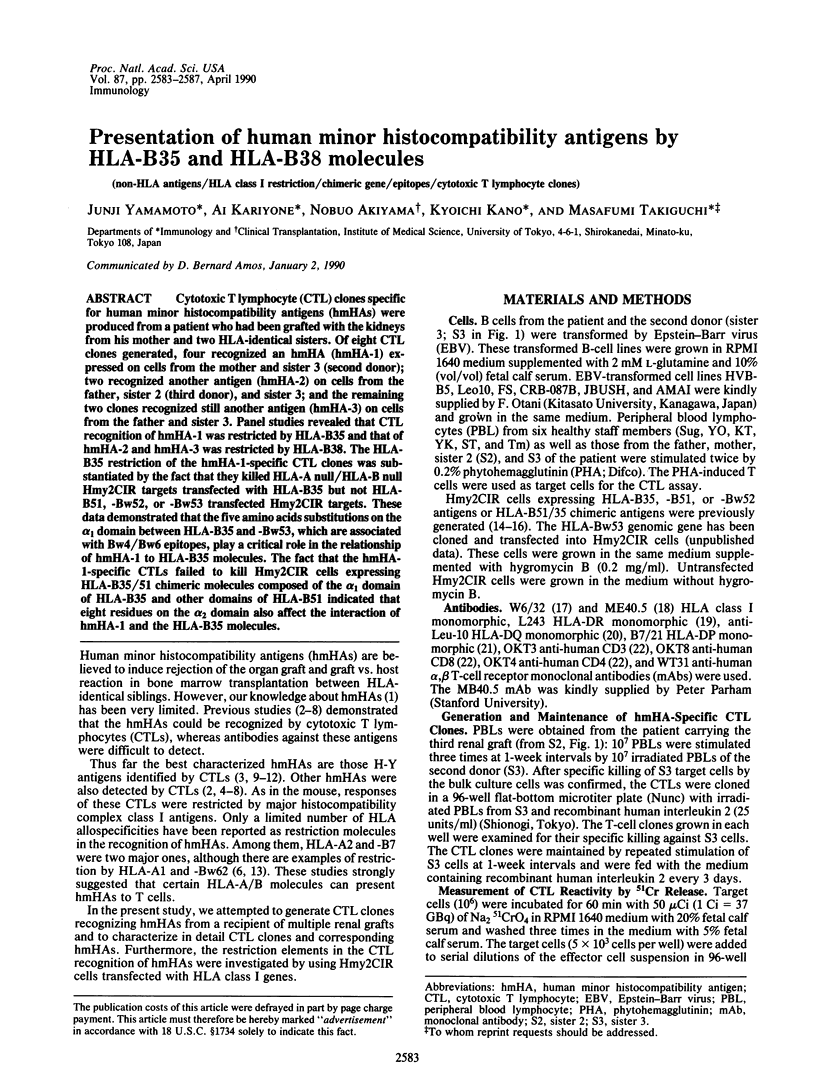
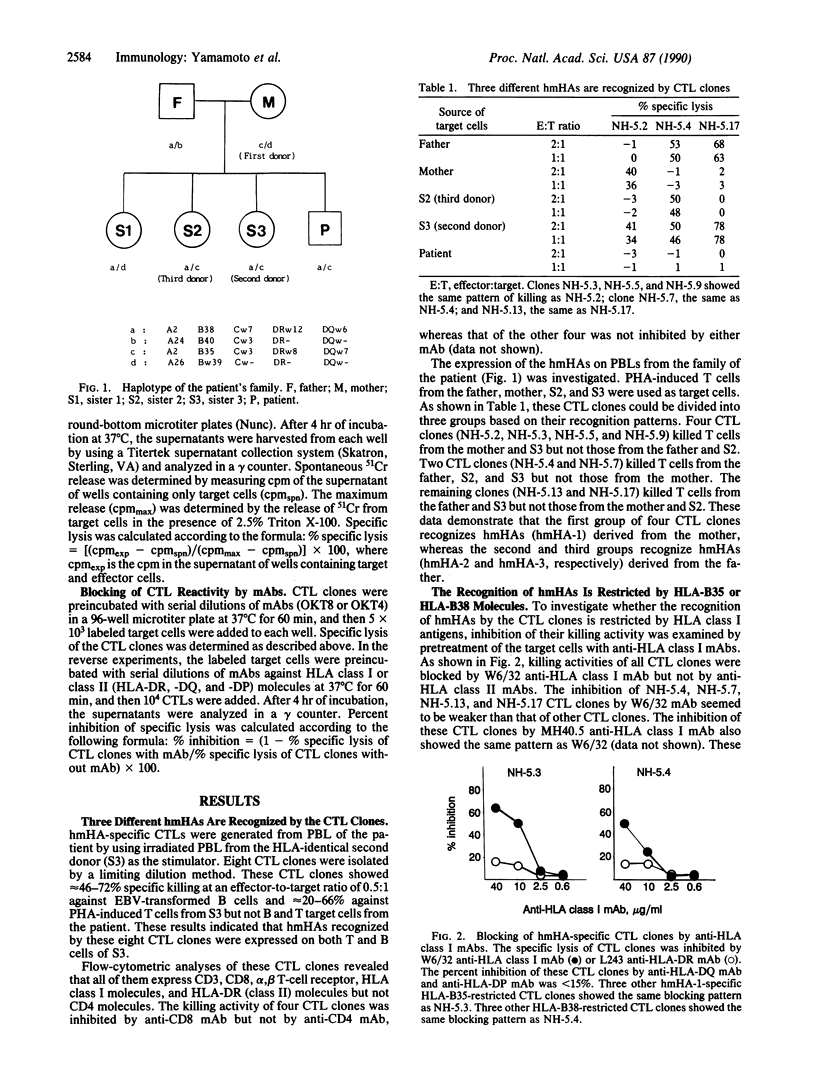
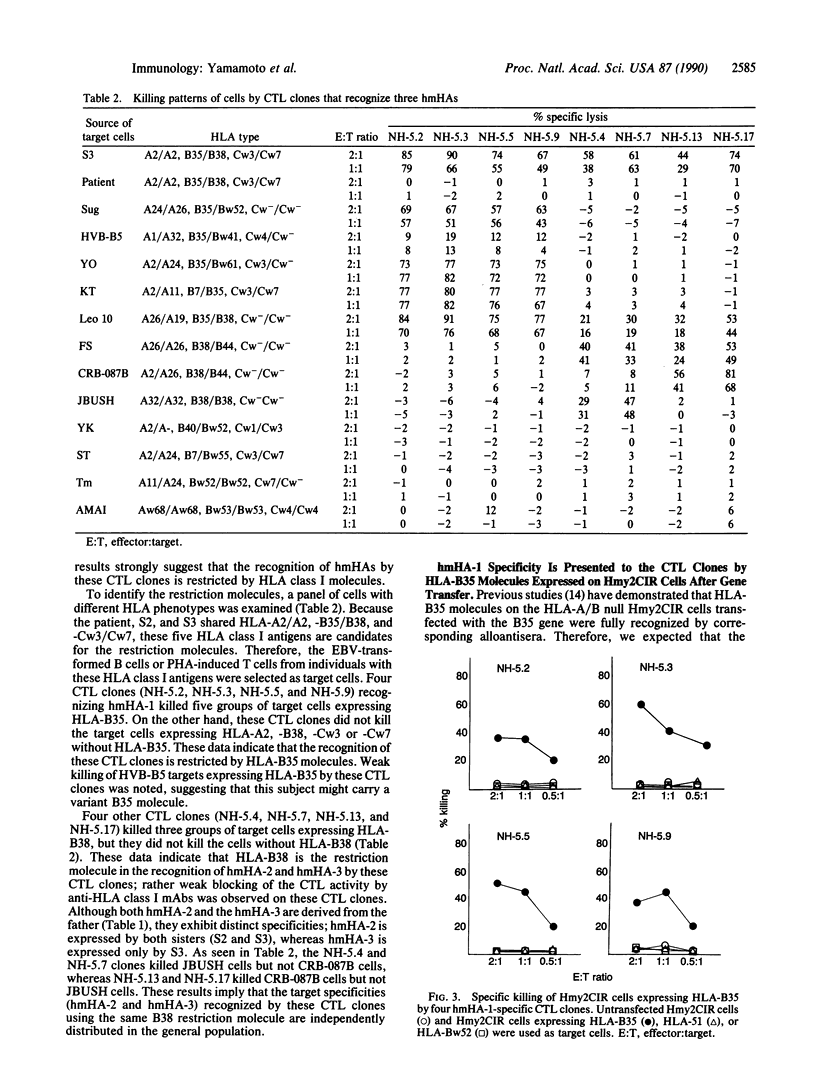
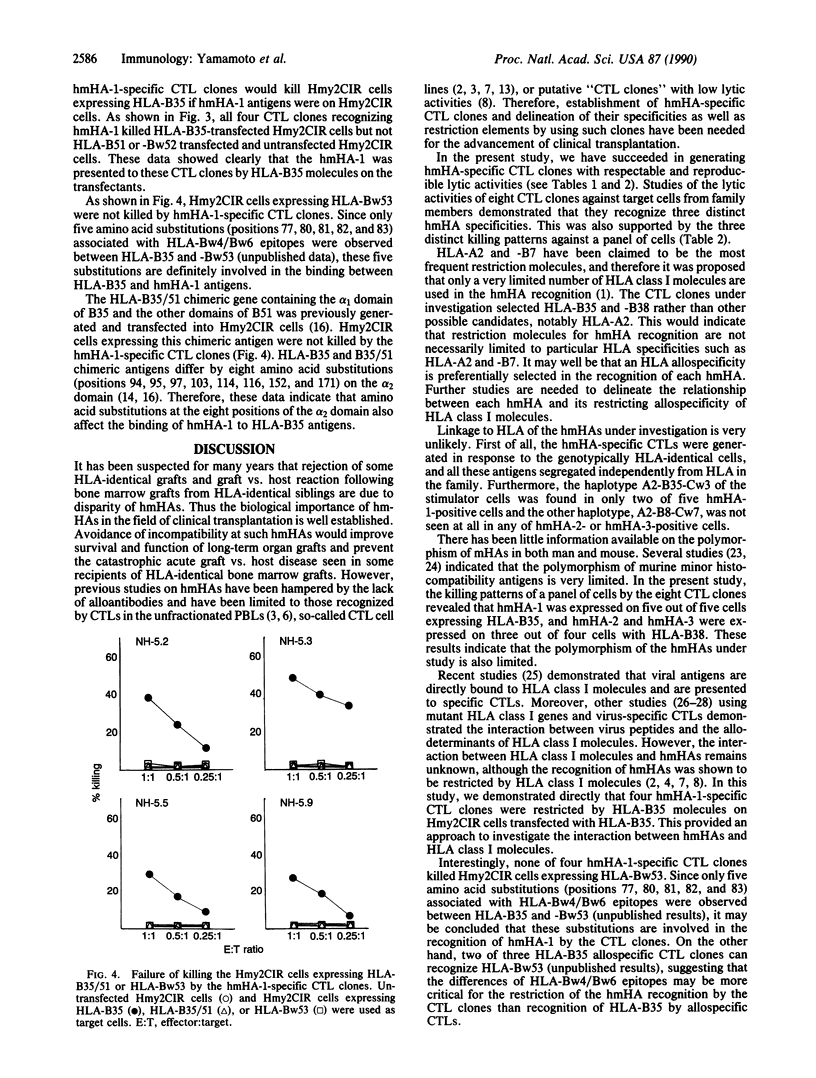
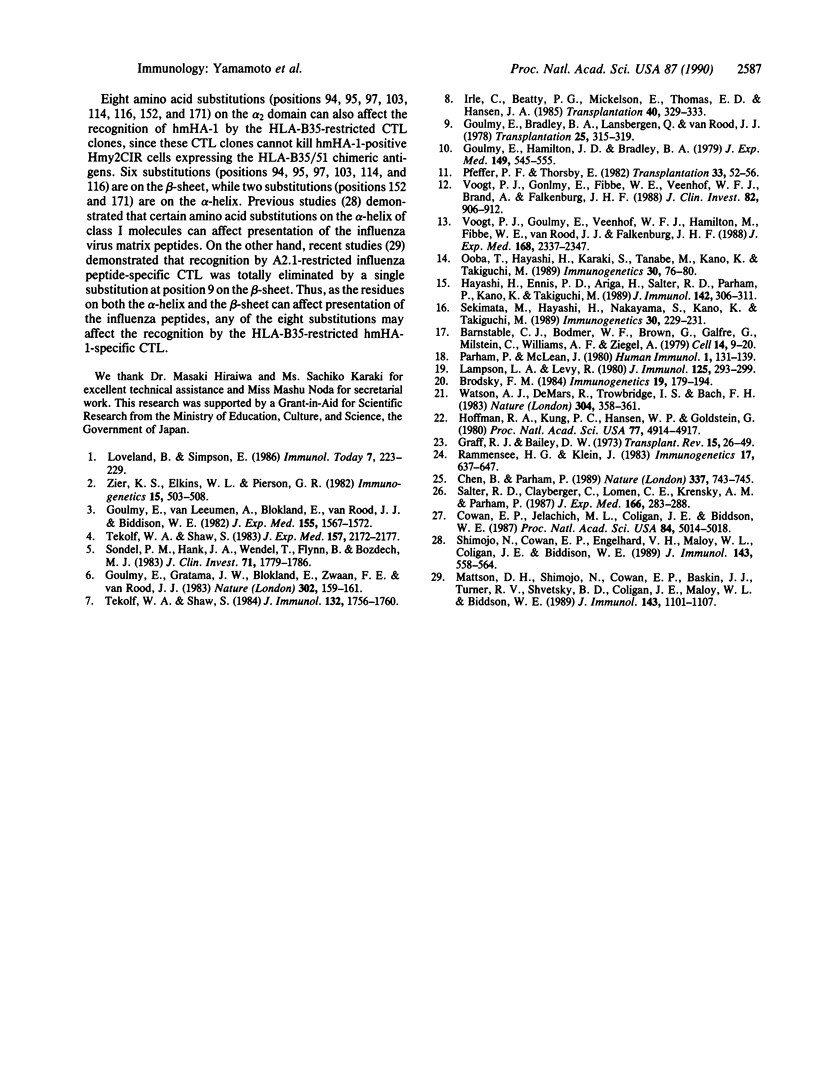
Selected References
These references are in PubMed. This may not be the complete list of references from this article.
- Barnstable C. J., Bodmer W. F., Brown G., Galfre G., Milstein C., Williams A. F., Ziegler A. Production of monoclonal antibodies to group A erythrocytes, HLA and other human cell surface antigens-new tools for genetic analysis. Cell. 1978 May;14(1):9–20. doi: 10.1016/0092-8674(78)90296-9. [DOI] [PubMed] [Google Scholar]
- Brodsky F. M. A matrix approach to human class II histocompatibility antigens: reactions of four monoclonal antibodies with the products of nine haplotypes. Immunogenetics. 1984;19(3):179–194. doi: 10.1007/BF00364762. [DOI] [PubMed] [Google Scholar]
- Chen B. P., Parham P. Direct binding of influenza peptides to class I HLA molecules. Nature. 1989 Feb 23;337(6209):743–745. doi: 10.1038/337743a0. [DOI] [PubMed] [Google Scholar]
- Cowan E. P., Jelachich M. L., Coligan J. E., Biddison W. E. Site-directed mutagenesis of an HLA-A3 gene identifies amino acid 152 as crucial for major-histocompatibility-complex-restricted and alloreactive cytotoxic-T-lymphocyte recognition. Proc Natl Acad Sci U S A. 1987 Jul;84(14):5014–5018. doi: 10.1073/pnas.84.14.5014. [DOI] [PMC free article] [PubMed] [Google Scholar]
- Goulmy E., Bradley B. A., Lansbergen Q., van Rood J. J. The importance of H-Y incompatibility in human organ transplantation. Transplantation. 1978 Jun;25(6):315–319. doi: 10.1097/00007890-197806000-00007. [DOI] [PubMed] [Google Scholar]
- Goulmy E., Gratama J. W., Blokland E., Zwaan F. E., van Rood J. J. A minor transplantation antigen detected by MHC-restricted cytotoxic T lymphocytes during graft-versus-host disease. Nature. 1983 Mar 10;302(5904):159–161. doi: 10.1038/302159a0. [DOI] [PubMed] [Google Scholar]
- Goulmy E., Hamilton J. D., Bradley B. A. Anti-self HLA may be clonally expressed. J Exp Med. 1979 Feb 1;149(2):545–550. doi: 10.1084/jem.149.2.545. [DOI] [PMC free article] [PubMed] [Google Scholar]
- Goulmy E., van Leeuwen A., Blokland E., van Rood J. J., Biddison W. E. Major histocompatibility complex-restricted H-Y-specific antibodies and cytotoxic T lymphocytes may recognize different self determinants. J Exp Med. 1982 May 1;155(5):1567–1572. doi: 10.1084/jem.155.5.1567. [DOI] [PMC free article] [PubMed] [Google Scholar]
- Graff R. J., Bailey D. W. The non-H-2 histocompatibility loci and their antigens. Transplant Rev. 1973;15:26–49. doi: 10.1111/j.1600-065x.1973.tb00109.x. [DOI] [PubMed] [Google Scholar]
- Hayashi H., Ennis P. D., Ariga H., Salter R. D., Parham P., Kano K., Takiguchi M. HLA-B51 and HLA-Bw52 differ by only two amino acids which are in the helical region of the alpha 1 domain. J Immunol. 1989 Jan 1;142(1):306–311. [PubMed] [Google Scholar]
- Hoffman R. A., Kung P. C., Hansen W. P., Goldstein G. Simple and rapid measurement of human T lymphocytes and their subclasses in peripheral blood. Proc Natl Acad Sci U S A. 1980 Aug;77(8):4914–4917. doi: 10.1073/pnas.77.8.4914. [DOI] [PMC free article] [PubMed] [Google Scholar]
- Irle C., Beatty P. G., Mickelson E., Thomas E. D., Hansen J. A. Alloreactive T cell responses between HLA-identical siblings. Detection of anti-minor histocompatibility T cell clones induced in vivo. Transplantation. 1985 Sep;40(3):329–333. doi: 10.1097/00007890-198509000-00021. [DOI] [PubMed] [Google Scholar]
- Lampson L. A., Levy R. Two populations of Ia-like molecules on a human B cell line. J Immunol. 1980 Jul;125(1):293–299. [PubMed] [Google Scholar]
- Mattson D. H., Shimojo N., Cowan E. P., Baskin J. J., Turner R. V., Shvetsky B. D., Coligan J. E., Maloy W. L., Biddison W. E. Differential effects of amino acid substitutions in the beta-sheet floor and alpha-2 helix of HLA-A2 on recognition by alloreactive viral peptide-specific cytotoxic T lymphocytes. J Immunol. 1989 Aug 15;143(4):1101–1107. [PubMed] [Google Scholar]
- Ooba T., Hayashi H., Karaki S., Tanabe M., Kano K., Takiguchi M. The structure of HLA-B35 suggests that it is derived from HLA-Bw58 by two genetic mechanisms. Immunogenetics. 1989;30(2):76–80. doi: 10.1007/BF02421534. [DOI] [PubMed] [Google Scholar]
- Parham P., McLean J. Characterization, evolution, and molecular basis of a polymorphic antigenic determinant shared by HLA-A and B products. Hum Immunol. 1980 Sep;1(2):131–139. doi: 10.1016/0198-8859(80)90100-7. [DOI] [PubMed] [Google Scholar]
- Pfeffer P. F., Thorsby E. HLA-restricted cytotoxicity against male-specific (H-Y) antigen after acute rejection of an HLA-identical sibling kidney: clonal distribution of the cytotoxic cells. Transplantation. 1982 Jan;33(1):52–56. doi: 10.1097/00007890-198201000-00011. [DOI] [PubMed] [Google Scholar]
- Rammensee H. G., Klein J. Polymorphism of minor histocompatibility genes in wild mice. Immunogenetics. 1983;17(6):637–647. doi: 10.1007/BF00366131. [DOI] [PubMed] [Google Scholar]
- Salter R. D., Clayberger C., Lomen C. E., Krensky A. M., Parham P. In vitro mutagenesis at a single residue introduces B and T cell epitopes into a class I HLA molecule. J Exp Med. 1987 Jul 1;166(1):283–288. doi: 10.1084/jem.166.1.283. [DOI] [PMC free article] [PubMed] [Google Scholar]
- Sekimata M., Hayashi H., Nakayama S., Kano K., Takiguchi M. Serological demonstration of HLA-Bw4/Bw6 epitopes on hybrid molecules between HLA-B35 and HLA-B51. Immunogenetics. 1989;30(3):229–231. doi: 10.1007/BF02421213. [DOI] [PubMed] [Google Scholar]
- Shimojo N., Cowan E. P., Engelhard V. H., Maloy W. L., Coligan J. E., Biddison W. E. A single amino acid substitution in HLA-A2 can alter the selection of the cytotoxic T lymphocyte repertoire that responds to influenza virus matrix peptide 55-73. J Immunol. 1989 Jul 15;143(2):558–564. [PubMed] [Google Scholar]
- Sondel P. M., Hank J. A., Wendel T., Flynn B., Bozdech M. J. HLA identical leukemia cells and T cell growth factor activate cytotoxic T cell recognition of minor locus histocompatibility antigens in vitro. J Clin Invest. 1983 Jun;71(6):1779–1786. doi: 10.1172/JCI110933. [DOI] [PMC free article] [PubMed] [Google Scholar]
- Tekolf W. A., Shaw S. In vitro generation of cytotoxic cells specific for human minor histocompatibility antigens by lymphocytes from a normal donor potentially primed during pregnancy. J Exp Med. 1983 Jun 1;157(6):2172–2177. doi: 10.1084/jem.157.6.2172. [DOI] [PMC free article] [PubMed] [Google Scholar]
- Tekolf W. A., Shaw S. Primary in vitro generation of cytotoxic cells specific for human minor histocompatibility antigens between HLA-identical siblings. J Immunol. 1984 Apr;132(4):1756–1760. [PubMed] [Google Scholar]
- Voogt P. J., Goulmy E., Fibbe W. E., Veenhof W. F., Brand A., Falkenburg J. H. Minor histocompatibility antigen H-Y is expressed on human hematopoietic progenitor cells. J Clin Invest. 1988 Sep;82(3):906–912. doi: 10.1172/JCI113697. [DOI] [PMC free article] [PubMed] [Google Scholar]
- Voogt P. J., Goulmy E., Veenhof W. F., Hamilton M., Fibbe W. E., Van Rood J. J., Falkenburg J. H. Cellularly defined minor histocompatibility antigens are differentially expressed on human hematopoietic progenitor cells. J Exp Med. 1988 Dec 1;168(6):2337–2347. doi: 10.1084/jem.168.6.2337. [DOI] [PMC free article] [PubMed] [Google Scholar]
- Watson A. J., DeMars R., Trowbridge I. S., Bach F. H. Detection of a novel human class II HLA antigen. 1983 Jul 28-Aug 3Nature. 304(5924):358–361. doi: 10.1038/304358a0. [DOI] [PubMed] [Google Scholar]
- Zier K. S., Elkins W. L., Pierson G. R. Cytotoxic T lymphocyte lines (CTLL) against a human minor alloantigen. Immunogenetics. 1982;15(5):501–508. doi: 10.1007/BF00345909. [DOI] [PubMed] [Google Scholar]


